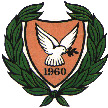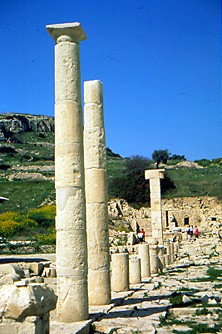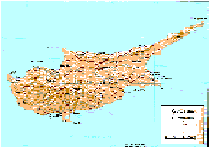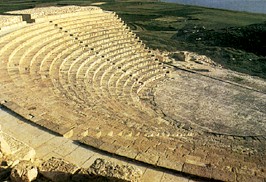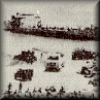 The Republic of Cyprus
The Republic of Cyprus
Cyprus became an independent republic on the 16th of August 1960. It is a member of the United Nations, the Council of Europe, the Commonwealth and the Non-Aligned Movement. Currently, the Republic of Cyprus began negotiations to become member of the European Union. For more information click on the Republic of Cyprus logo to visit the official site of the Republic of Cyprus.


Cyprus at a glance
Cyprus is an island with superb mountains (Troodos Mountain - 3700
feet height) forests, fascinating coastlines and beaches as well as places
of great historical and archaeological importance. Cyprus has 6 cities:
Nicosia, which is the capital city, Famagusta, Larnaca, Limassol, Kyrenia
and Paphos. Nicosia which is the capital of Cyprus since the 10th
century AD has many places of interest like the Cyprus Museum, containing
works of art found in the island of Cyprus from the Neolithic era (5.800
BC) to the Roman period (300 AD). Furthermore we have the St. John's
Cathedral, the Seat of the Greek Orthodox Church of Cyprus with the Archbishopric
(the house of the Archbishop of Cyprus). The dominand religion in
Cyprus is Greek-Othodox Christianity which celebrates 2000 years now.
Limassol is the second largest city of Cyprus and chief exporting town. It is also the center of the wine trade. Cyprus has along history and tradition in wine making. Cyprus Wine is one of the best wines in the region.
Larnaca is most famous for the airport (international Airport of Cyprus)
which is near the Salt Lake. The Salt Lake attracts thousands of migrant
flamingoes (particularly during winter). Moreover Larnaka has the
famous church of St. Lazarus the man who Jesus Christ raised from the dead
(Holy Bible).
Cyprus food is also rewarding. There are so many exciting dishes
to try such as meze: Cyprus magnificent glorified hors d'oeuvres, including
koupepia (staffed vine leaves) afelia (fried pork) kebabs, moussaka and
wine ofcourse to accompany them.
The Turkish Invasion
- 1974 Turkrey
invades Cyprus violating all principles governing international relations
and the UN Charter. As a result of the brutal invation, 37% of the
island is occupied by the Turkish troops, 40% of the populationwas violently
uprooted and thousands of civilians were killed or disappeared without
trace. Click on the icon to read more about the Turkish Invation
The Missing People - 1619 people are still missing since the Turkish invasion in 1974. Turkey refuses to cooperate in finding what happen to these people; whether they are still alive or killed by the Turkish troops ! ! ! Click on the icon for more information about the missing people.
